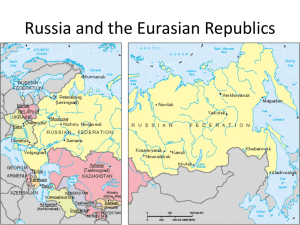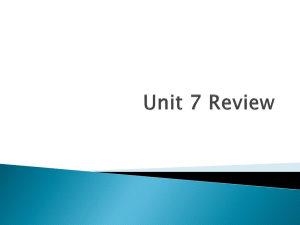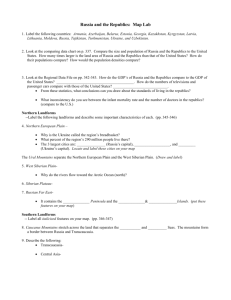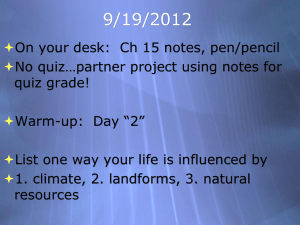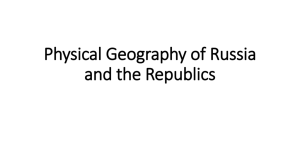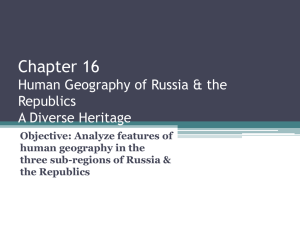File - Ms. Cherry`s Homework Page
advertisement
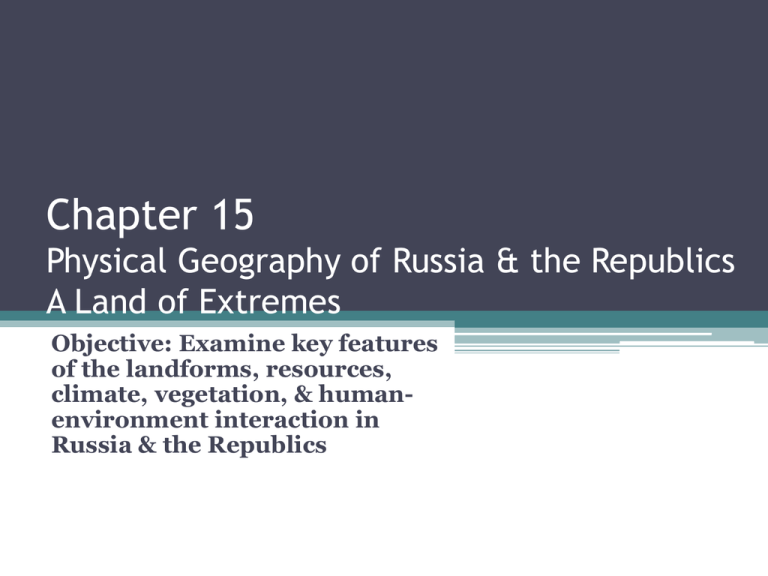
Chapter 15 Physical Geography of Russia & the Republics A Land of Extremes Objective: Examine key features of the landforms, resources, climate, vegetation, & humanenvironment interaction in Russia & the Republics Chapter 15 Section 1 Landforms & Resources Vocabulary: Chernozem, Ural Mountains, Eurasia, Transcaucasia, Central Asia, & Siberia Objective: Identify resources & explain why they are difficult to develop Northern Landforms • Russia & the Republics cover over eight & a half million square miles • The Northern European plain contains chernozem “fertile soil” & most agriculture takes place here • 75% of population live in this region (major cities Moscow, St. Petersburg, & Kiev) • Ural Mountains divides Europe & Asia in the West Siberian Plain Southern Landforms • Transcaucasia contains Armenia, Azerbaijan, & Georgia • Central Asia includes Kazakhstan, Kyrgyzstan, Tajikistan, Turkmenistan, & Uzbekistan • High ranges contribute to the arid climate of Central Asia Rivers & Lakes • The main drainage basins in Russia & the Republics are the Arctic Ocean, Caspian Sea, Pacific Ocean, Baltic Sea, Black Sea, & Aral Sea Basins • The Volga River carries 60% of Russia’s river traffic • The Caspian & Aral Sea are two of the largest seas & both are saltwater • Lake Baikal is the deepest lake in the world & holds 20% of the world’s fresh water Regional Resources • Russia & the Republics boast huge reserves of coal, deposits of iron ore, other metals, oil, & natural gas • Russia’s vast forests hold 1/5th of the world’s timber resources • Harsh climate, rugged terrain, & vast distances make it difficult for Russia & the Republics to remove resources from the ground & transport them to markets • Resources are found in Siberia (frigid arctic & subarctic region) Chapter 15 Section 2 Climate & Vegetation Vocabulary: Continentality & Taiga Objective: Describe four major vegetation regions of Russia & the Republics A Climate of Extremes • Humid continental & subarctic climates dominate much of Russia & the Republics • Siberia average temperatures rarely exceed 50 degrees & sometimes drop below -90 degrees • Some areas consist of permafrost • Central Asia however have semiarid & desert climates • Transcaucasia has a subtropical climate zone Vegetation Regions • Tundra: in the Arctic climate zones very few types of vegetation are able to survive • Forest: also known as the Taiga • Steppe: grassland that where fertile soil is found (produces mostly grain) • Desert: two main deserts are the Kara Kum & Kyzyl Kum Chapter 15 Section 3 Human-Environment Interaction Vocabulary: Runoff & TransSiberian Railroad Objective: Describe how Russia’s harsh winter has been both an obstacle & an advantage to the country The Shrinking Aral Sea • In the 1950s officials began to take large amounts of water from the rivers to irrigate Central Asia’s cotton fields • Since the 1960s the sea has begun to evaporate • Pesticides & fertilizers runoff into the Aral sea killing all of the native species of fish • Pollution has caused drastic increases in diseases like throat cancer & respiratory diseases • Child mortality rates in Central Asia are among the highest in the world The Russian Winter • 32 million people make their homes in Siberia • Temperatures drop so low in Siberia that basic human activities become painful • However, warmer weather melts the ice & creates pools of water that attract mosquitoes & black flies • They build on top of concrete pillars to make sure their buildings don’t sink in summer • However its has helped to protect them from invasion of European armies Crossing the “Wild East” • Russia’s emperor ordered work to start on the Trans-Siberian Railroad that would link Moscow to Vladivostok • It covers 5700 miles & crosses seven time zones • Russian officials also started this project to populate Siberia to make profit off of its resources
